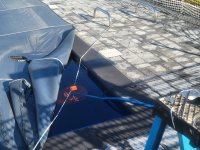I live in Tulsa, ok area and for 20 years have used cheap 30x50 tarp and water tubes to close pool. However, we decided to try a mesh cover this year because well, you know, “the tarp is so ugly and the tubes and the……..” So we paid $6000 to have a Meyco Rugged Mesh safety cover installed. I have a fairly big pool, and it is irregular shaped. Here’s the result after pulling the cover off on Memorial Day. (I have better video but I can’t post those)
We have 25 mature trees on our lot, mostly huge oak trees. In the spring, there is a lot of 2-3” twigs of yellow pollen balls that are so numerous they require a wheat scoop to clean them up off of the surrounding pool deck. Needless to say, the way in which the cover lays on pool surround was inadequate to keep those out of the pool. Additionally, there was. LOT of good old fashioned dirt in the pool. Needless to say, I’m irate.
So next year, I’ll use the over priced mesh cover to support yet another cheap tarp and water tubes and hopefully that will mitigate the tarp from sagging in and collecting rain water and leaves in fall and rain water and pollen fur balls in the spring.
So if you need a safety cover to protect children and pets, go ahead. But know that depending on your surrounding flora and fauna, you’ll need extra protection.
We have 25 mature trees on our lot, mostly huge oak trees. In the spring, there is a lot of 2-3” twigs of yellow pollen balls that are so numerous they require a wheat scoop to clean them up off of the surrounding pool deck. Needless to say, the way in which the cover lays on pool surround was inadequate to keep those out of the pool. Additionally, there was. LOT of good old fashioned dirt in the pool. Needless to say, I’m irate.
So next year, I’ll use the over priced mesh cover to support yet another cheap tarp and water tubes and hopefully that will mitigate the tarp from sagging in and collecting rain water and leaves in fall and rain water and pollen fur balls in the spring.
So if you need a safety cover to protect children and pets, go ahead. But know that depending on your surrounding flora and fauna, you’ll need extra protection.








